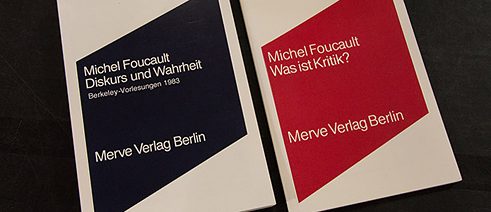Brilliant Dilletantes
Dilettantism as Pose – Merve Publishers

Merve Publishers and its theory volumes was the insider’s tip among students in the 1980s. Today the publishing house has become a cult and still publishes its books on the same principle as then: not to sell, but to stir up discussion.
In the 1980s, to turn up in the West Berlin pub scene with a 300 page book by Michel Foucault was unthinkable. “You wouldn’t be taken seriously”, says Tom Lamberty. “With a small volume of Foucault from Merve in your pocket, however, you were regarded as extremely cool.” The big market for the legendary Berlin publisher back then was West Berlin student pubs. Hours-long discussions resulted then in projects that became new Merve books – such as, for instance, Geniale Dilletanten (i.e., Brilliant Dilletantes) by Wolfgang Müller.
That the founder of Merve, Peter Gente, and his future wife and co-publisher Heidi Paris described themselves as dilettantes was, observes Lamberty, who has headed the firm since 2007, an ironic gesture, which fit the then prevailing zeitgeist of punk and New Wave. “The term consorted well with another, ‘hobbyist’, which they also used to describe their publishing activities. With these designations they intentionally down-pedalled themselves and assumed the attitude of a deliberate dilettantism. It was more a pose.” A pose because the makers of Merve were authorities rather than dilettantes. They knew very well of course that “dilletante” isn’t spelled with two “ls” and one “t”, and that the “new French philosophers” and pop culture are powerful discourses.
The book as tool
The publishing house, which was founded in 1970 as a collective and initially addressed itself to seeking political alternatives to dogmatic Marxism, turned in the late 1970s mainly to the post-structuralists such as Paul Virilio, Michel Foucault and Gilles Deleuze. These thinkers, not taken seriously back then in Germany but today part of everyone’s theoretical repertoire, were first published in German by Merve. The rest of the publishing programme reads in part like a Who’s Who of West Berlin: Blixa Bargeld’s poems, Rainald Goetz’s Jahrzehnt der schönen Frauen (i.e., Decade of Beautiful Women) and Thomas Kapielski’s Gottesbeweise (i.e., Proof of God’s Existence). The appeal of the Merve volumes consisted in their opening of borders: here theory and art, philosophy and pop belonged together. “It was about freeing yourself from ideologies and having arguments in hand against conservative profs”, says Lamberty, explaining Merve’s success. This opening up of discourse is also the reason that students still look upon the smart little Merve pocket books as cool and that they are a permanent feature in museum bookshops.“The Merve idea was the book as a tool, as an object reduced to the essentials”, says Lamberty. And so it has remained. Nothing has changed about the pocket-sized format and minimalist design of a monochromatic rhombus on a white background. Not only in design but also in content it was also the small form that made for success. Merve published not big works but short essays. “You could read them in an hour, extract the most important arguments, then go to the pub and start talking.” And that was what it was about. “There was a real fury of discussion”, recalls Lamberty – in the pub, in the flat share, at the university. “At Merve the discussions were even recorded on tape, listened to with fast forward and rewind, and what was heard was discussed again and again recorded. The discussions were more or less looped in endless loops.” This zeal, says Lamberty, can be accounted for as a response to the post-war silence: everything now had to be questioned, even the self.
End of the truffle pig
And it was worth it. The books sold. The bestseller Rhizome by Gilles Deleuze and Félix Guattari sold over 20,000 copies. “The publishers were able to live on that and sometimes take a year when they did nothing but go to concerts and read books.” But this was over in 1989. With the fall of the Berlin Wall, the front between German and French philosophy also crumbled. To be theoretically avant-garde and relatively successful was no longer so easy as before. “Peter Gente had the function of a truffle pig. Now every blogger can do that”, says Lamberty, meaning the selection of valuable contents.With an annual turnover of 160,000 euros, the publishing house still writes a black zero. But with Merve it was never about money. At the beginning, there was a statement on the back of the books to the effect that Merve was a non-profit company and any profit was invested in new books. That remains so today. “We could certainly go bigger. But I don’t want to have to grapple with grant applications and logo sizes. It distracts me much too much from what I really want to do.” And that is still the making known of theoretical approaches that stir up the mainstream discourse.